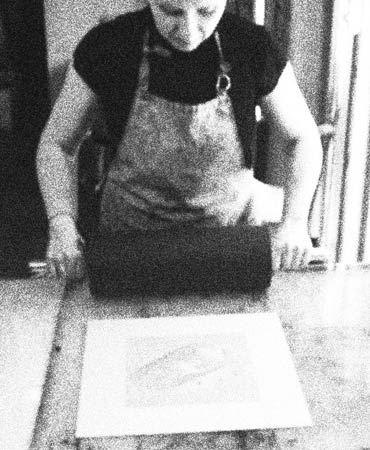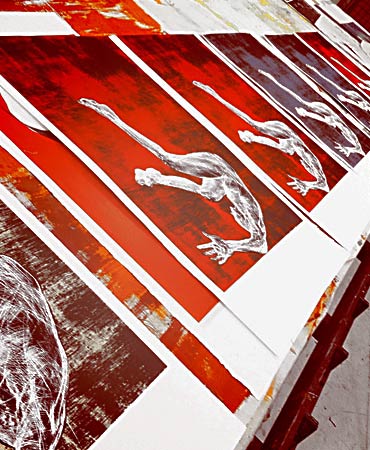
“I am interested in many ways of printing and manipulating images, my practice incorporates etching, silkscreen and lithography, I also use collograph and print on various papers to create truly unique pieces.”
Printmakers, print dealers, and print collectors use several terms that are necessary for the comprehension of prints:
Edition, Numbering, Artist’s Proofs.
Edition: The number of images printed from the plate, stone, block, or the like is called an edition. The body of the edition is numbered (for example, 1/100 through 100/100) directly on the print. Additional proofs, such as artist’s proofs, are also part of the edition.
Numbering: Numbering indicates the size of the edition and the number of each particular print. Therefore, 25/75 means that the print is the 25th impression from an edition of 75.
Artist’s Proofs: These impressions are in addition to the numbered edition and are so noted in pencil as artist proof or A/P. The legitimate number of artist’s proofs for a given edition is usually around 10% of the total.

An etching is created by covering a metal plate with an acid-resistant layer of wax called a ground and drawing a design through the ground using an etching needle. The plate is then dipped in acid, which bites into the exposed lines, thus etching the design into the plate. The plate is then inked and wiped carefully and thoroughly to take off all surplus color. Printing. The plate is positioned on the flat bed of the press and the damp paper is laid over the top. The felt blankets are spread over and the handle of the press is turned to run the bed between the rollers. Different ways of manipulating the mark-making process, the action and extent of corrosion, and the printing process give the artist an infinite range of creative opportunities.

Original lithographs are hand drawn by the artist on a specially prepared zinc plate. The process depends on a simple chemical principle – the mutual antipathy of grease and water. The image is drawn with greasy materials on a grease-sensitive surface, with the non-printing areas treated with water based materials to keep them clean. When printing ink is rolled on, it adheres only to the sensitized greasy marks. The inked image is then printed using an offset process. With an offset press, the ink from the plate is transferred to a rubber blanket, and from that blanket onto paper.

Screen printing is a printing technique that uses a woven mesh to support an ink-blocking stencil. The stencil forms open areas of mesh that transfer ink onto receiving material by sharp edged tool (squeegee). A squeegee is moved across the screen stencil, forcing ink past the threads of the woven mesh in the open areas. Silkscreen method produces sharp clean images and great for layering the colours and images.
FAQS
“AN ORIGINAL PRINT IS A WORK OF ART THAT CANNOT BE PRODUCED ANY OTHER WAY”
I tend to work between a variety of printmaking media / methods each complementing the ideas explored at the time. This ensures that the print is not purely individual or unique at a technical level but rather the fusion of ideas with execution means that the print itself could have not been created in any other way. This in a very real sense is what makes the body of work original.
“JUST BECAUSE MULTIPLES ARE INVOLVED IT DOES NOT DENUDE THE WORK OF ITS ORIGINALITY”
The question of confusion comes from how every artist approaches aspects of repetition and deviation, especially when it comes to the editioning of work (making multiple copies). There is a wide scale between systematic control in order to make images alike and the endless creative possibilities that allow for infinite variations. Beyond the rigid tradition of Old Master’s printmaking, these days artists are freer to use printmaking as means of expression rather then means to produce multiples. On a personal note all my prints are hand made by me and no two copies are identical due to the variability of the printmaking process.
“THE PRINTMAKING PROCESSES AND ITS TECHNICAL RIGOUR INFLUENCES THE FINAL MESSAGE”
For me the process of printmaking revolves around its iterative nature, a repeating process where one iteration is used as the starting point for the next iteration. A continual evolutionary process in which each step in the production cycle forges the ultimate output. The medium therefore influences the work and becomes part of the message.
“UNIQUE ARTISTIC INTENTION DRIVES ORIGINALITY”
At the end it is a unique artistic intention that makes a print an original work of art – from conceiving an idea to giving it a form and a physical presence. It is the unique set of artist’s skill, talents and experiences that make the work of art truly original.
“TECHNIQUE OR ‘INSPIRATION’?”
The process is a dialogue / balance between two powerful sides of human nature: instinct and intelligence. Where an artist can be simultaneously an improviser and a constructor. It is the tension between control on the one hand, and an eagerness to accept and embrace mistakes on the other.
“WHY I DRAW WHAT I DRAW AND HOW I DRAW IT…”
Most of my works are drawn freehand directly onto a zinc matrix plate. I do not make changes to my line drawings; I have learnt to trust my hand. I do not use models either. Knowing the physical structure of a body is akin to appreciating the inner workings of a spirit that abides within it. I aim to create a tactile relative to our human experience; to take an intangible and make it into something tangible. To simply transform that which we cannot explain in words and translate it into an experience.